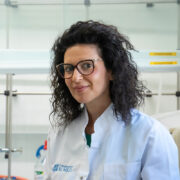
Biographical notes
Dr. Maria De Rosa holds the role of Principal Investigator in the Medicinal Chemistry Group at the Ri.MED Foundation since 2019. She graduated cum laude, receiving a master’s degree in Pharmaceutical Chemistry and Technologies, from La Sapienza, Rome University, and completed her doctoral studies in Pharmaceutical Sciences at the University of Siena, under the supervision of Prof. Federico Corelli. During the training experience, she focused her research activities mainly on heterocyclic chemistry, by designing and developing (i) new indole scaffold molecules as potential antivirals (antiHIV-1); (ii) novel quinolones both as potential inhibitors of Mtb Topoisomerase IV (Mycobacterium of tuberculosis) as well as inhibitors of cannabinoid receptors CB1 and CB2. Part of the doctoral studies were carried out in Germany, at RWTH, University of Aachen, under the co-guidance of Prof. Carsten Bolm. Here, she consolidated her knowledge relating to sulfoximine chemistry, via the design and synthesis of cyclooxygenase inhibitors (COX-2, therapeutic area of inflammation). Before joining Ri.MED, she worked for five years in Sweden, in the laboratories of Uppsala University. Initially, she joined the Department of Pharmaceutical Sciences as a post-doctoral researcher; here, inspired by her mentor Prof. Matz Larhed, mainly explored small molecules and peptidomimetics chemistry, contributing to several medicinal chemistry programs in the therapeutic area of viral and bacterial infections (HIV-1 and Tuberculosis, respectively). Subsequently, at the Department of Biological and Molecular Sciences of the same University, she worked as an independent researcher consolidating her background as a medicinal chemist and becoming an expert in peptides and peptidomimetics chemistry.
In 2019, she was appointed as Principal Investigator in Medicinal Chemistry at Ri.MED Foundation, with the main tasks of designing and setting up the first Medicinal Chemistry Laboratory. One more task was the creation of the first team of Medicinal Chemistry. As a reference person of the team, she guides and coordinates the human resources as well as the scientific research activities. She is a co-tutor of a doctoral student in collaboration with the University of Palermo. Over the years, she gained experience as a medicinal chemist in drug discovery processes, with the ability to design and develop de-novo molecules for therapeutic targets of interest.
Scientifical activity
During her training and professional experience, Dr. Maria De Rosa focused her research activities on the design and synthesis of novel molecules with potential biological activity toward several therapeutic targets, in the areas of infection, neurodegeneration, inflammation, and cancer. She consolidated her skills in pharmaceutical chemistry implementing her expertise in small molecules, peptides, and peptidomimetics chemistry. She was also engaged in the acquisition of transversal skills related to the target’s knowledge (molecular mechanism, protein structure, rationalization of the binding modes with known inhibitors and/or natural substrates). More in general, she always worked in multidisciplinary contexts, developing skills in the field of early drug discovery processes (discovery of new hits, confirmation of the chemotype and expansion of the chemical family, structure-activity relationship studies and structural optimization, hit-to-lead). To give some examples, with regard to infectious diseases, Dr. Maria De Rosa had the opportunity to work on HIV-1 infection, designing and synthesizing indole scaffold-based molecules (master thesis) and peptidomimetics analogs of the transition state (postdoctoral fellowship in Sweden) with inhibitory activity towards HIV-1 aspartic protease. The doctoral studies focused on the chemistry of quinolones, with the design and preparation of mini-libraries explored as potential antitubercular entities (Topoisomerase IV inhibitors) and as inhibitors of cannabinoid receptors CB1 and CB2. The aim of this second project was to study and rationalize, upon structural modifications, the selectivity of the chemotype towards the two types of receptors.
A few compounds highly potent and with an interesting pharmacokinetic profile were obtained. This allowed the researcher to contribute to an in vivo study on a mouse model of nociception. Furthermore, she had the opportunity to investigate the binding mode of some peptidomimetic inhibitors within the active site of HIV-1 aspartic protease, through crystallographic experiments. LepB peptidase was another target of interest, towards which peptidomimetic compounds were developed as potential anti-tubercular inhibitors. Within the neurodegeneration area, a challenging project, in collaboration with the PET Center of Uppsala University, involved the planning and development of the cold chemistry protocol for the synthesis of potential radioactive tracers. Benzovesamicol (the tracer of acetylcholine vesicle transporter) analogues were prepared to be used as tool compounds for diagnostic purposes for Alzheimer’s disease. In the group of Prof. Carsten Bolm, in Germany, Dr. Maria De Rosa had the opportunity to approach a completely new chemistry with the design and synthesis of sulfoximine derivatives, as potential inhibitors of the COX-2 enzyme (inflammation area).
At the Ri.MED Foundation, the project of focus concerns the development of new allosteric modulators of NLRP3 (NLR pyrin domain-containing protein 3), a validated target for chronic inflammatory age-related diseases. Dr. Maria De Rosa, as the referent person of the Medicinal Chemistry group, coordinates and supervises the research activities, takes care of the management of the human resources and laboratory facilities, and coordinates the scientific activities of the team within the multidisciplinary drug discovery area. Moreover, the writing of projects and participation in national and international calls for the provision of funds is undoubtedly the focus of scientific activity.
